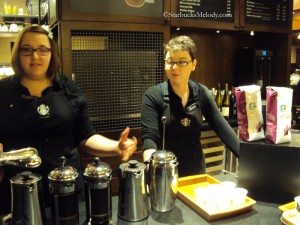 It is time to talk about the four fundamentals of making great coffee at home. If you don’t know all four, here they are:
It is time to talk about the four fundamentals of making great coffee at home. If you don’t know all four, here they are:
- Water – Use great water. It should be a filtered water, ideally.
- Proportion – Use the right amount of coffee for the amount of water you’re using.
- Freshness – Do not use old coffee. Once you open a bag of coffee, you should use it within seven days of opening.
- Grind – Make sure your coffee is ground to the right ground for your brew method. You’ll want to use a fine grind if using the coffee as a shot of espresso. Use a course grind if you’re making a French press.
At the East Olive Way Starbucks, the coffee masters are putting together two seminars on these four fundamentals. The first one was held on February 4, 2013, and the second one will be February 18, 2013. In the first seminar, the coffee masters discussed the importance of proportion and water.
I would love it if you would come to an East Olive Way coffee education seminar. This Starbucks is at 1600 East Olive Way, Seattle, WA 98102. You can call them at 206 568 – 5185.
Starbucks Coffee Master Megan and Starbucks Coffee-Master-In-Training Jesica led us through tonight’s lesson on water and proportion.
Proportion:
From my perspective, this part of the lesson was the most interesting to me. I have to admit that there are often times I’m a bit lazy about how I make coffee at home. I have been known to just ‘eye ball’ a bunch of coffee in a pour over, pour hot water over it, and call it good.
Starbucks recommends 2 tablespoons of coffee per six ounces of water. At tonight’s tasting, we compared coffee that was made with one tablespoon of coffee per six ounces of water, correctly made coffee, and coffee made with three tablespoons per six ounces of water.
Even side by side, there was definite difference in how the coffee looked in the cup. Coffee that too few grounds really is not very good! The coffee grounds become over saturated, causing the more bitter notes to be pronounced in the cup. As we tasted the coffees, we noticed that the coffee with too little coffee grounds was also not very aromatic at all. Too few grounds produces a water, over extracted coffee.
By the way, if you really want a watery coffee at home, tonight’s coffee masters suggested that you brew the coffee correctly. Then, after it is brewed, add a little more water. Of course, we all agreed that watery coffee is not that great, and “don’t try this at home.”
Coffee that was correctly made was indeed the best! Megan and Jesica used Casi Cielo for this “proportion” test, and the correctly made coffee had a nice dark chocolate aroma, and lovely chocolate flavor notes with a slight tartness to it.
The coffee made with three tablespoons of coffee per six ounces of water was somehow a little oilier, and just wasn’t very good. It’s a bit concentrated. Actually, this might not be terrible iced, since adding ice weakens a coffee. Still, don’t try this at home.
Here are the three cups from the proportion lesson. Can you tell which one is which?
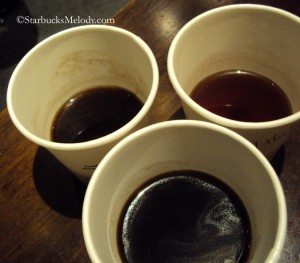 I will say, after this coffee seminar was over, I started measuring coffee at home, and instead of just guessing at it. You could kind of see a difference in the French presses too:
I will say, after this coffee seminar was over, I started measuring coffee at home, and instead of just guessing at it. You could kind of see a difference in the French presses too:
Water:
For the water portion of the seminar, Megan and Jessica made two French presses of Verona. One was made with Starbucks filtered water. The other was made with tap water. Again, there was noticeable difference between the two. I don’t think this was as dramatic though as the proportion part of the experiment. The fact of the matter is that Seattle’s tap water is pretty drinkable. I have feeling if we did this same experiment in Southern California, the result would be horrifying. The water in Southern California is horrible. One customer made a bad face drinking the coffee with unfiltered water.
There was one interesting thing about this part of the coffee seminar: the coffee made with city water had a noticeable film on the interior of the cup. The coffee made with Starbucks water was much cleaner in appearance, and the sides of the cup were cleaner too. In the photo of all five cups, the bottom two are part of the “water” experiment.
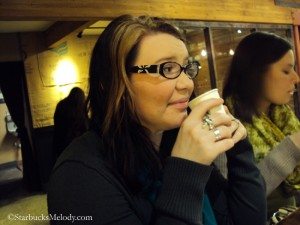 Hope you enjoyed this lesson in two of the four fundamentals to great coffee! You will get the second half of this series sometime after February 18th! I hope that if you’re in the Seattle area that you can come join in. Lastly, I took a photo of all five cups too:
Hope you enjoyed this lesson in two of the four fundamentals to great coffee! You will get the second half of this series sometime after February 18th! I hope that if you’re in the Seattle area that you can come join in. Lastly, I took a photo of all five cups too:
Related posts
23 Comments
Leave a Reply Cancel reply
You must be logged in to post a comment.
Sponsors
Recent Comments
- DEVIN on Compostable Straws Land in Seattle Starbucks Stores
- coffeebeanz on Why do you go to Starbucks less often? (If that’s true for you)
- Willi on You can now buy a Siren statue: $6,000
- Willi on A major revamp of your drink recipe: Testing syrup extracts and cane sugar
- Skip on Why do you go to Starbucks less often? (If that’s true for you)



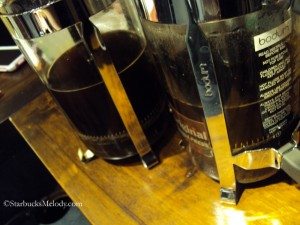
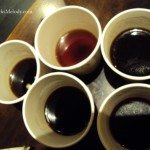



Just a quick flyby to give two thumbs up to this post, thanks Melody.
It is possible to follow the Four Fundamentals of Great Coffee without becoming obsessive about it.
Nice to see a post on the proper way to brew coffee at home. Dad Cooks it is sort of true that either you follow the four fundamentals to the letter all the time or you do it the first few times and then go back to the ways you were used to.
I’ve recently purchased a Breville YouBrew system – which addresses some of the four fundamentals. We immediately noticed a huge improvement in our coffee! We have decent water in our town, so I didn’t see the need to use filtered water, but I may give it a try now.
I wish more Starbucks locations offered classes like the ones in Seattle! I’ve never seen anyone order brewed coffee outside of the three daily offerings. The thought of ordering a french press or pour over – well, I’d think the baristas would look at me like I was crazy! Is that really something you can do in any Starbucks? Because I’d love to try more of the medium roasts without shelling out $11-15/pound to try them at home.
@Kat – Yes, you can ask for a pour over or french press of ANY roast that is available in the store – they can’t tell you no. You may have a longer wait til time if you order either during a rush, but as long as you’re patient, you’ll get it. There are instructions in my store beside our grinder on making a pour over. Some baristas are more confident than others when it comes to preparing a french press, but that doesn’t excuse you not being granted one. The shift supervisors and managers in my storr are awesome as far as helping those who are having trouble remembering. It is the perfect way to try the other coffees that aren’t offered daily anymore.
Melody, thanks so much for posting this – I’m forwarding this via email to those I know will benefit 🙂
Courtney B I have to let you know that indeed a store can say no to a pour over as in my district and at my local store they no longer do pour overs. They say they are not successful and feel that the brewing technique is more popular and their pour over maker does not work.
@purple1 – It is NOT supposed to be that way. Something is amiss in your district. You mentioned before that you spoke with a DM who district-wide approved “no pour overs.” That would never fly in Seattle. They have to be able offer what’s on the menu. If not a pour over, they could brew a half batch of coffee upon request. The bottom line is that coffee has an extremely high profit margin, and if they sell one single cup from a batch, they’ve usually broken even.
Could you try to contact the regional manager? Or at least call customer service?
Melody the SM at my local store told me the DM said that there would no longer be pour overs. I did not directly speak with the DM and have not seen him since this conversation. The SM was pretty clear that the DM did not want to do pour overs. One of the partners at my local store when I asked him about it said that they did not do pour overs however if I asked for him to brew a half batch of coffee he would do it for me. I was not clear from him if he would do it for anyone (although my guess is he would). I think before going to the regional manager or customer service I might try to contact the DM.
Thanks for the refresher! Sometimes we all get a little careless on the measuring. I have a coffee scoop I use, which (I think) is 2 tablespoons and so I use 1 scoop per cup…most people look at me like I’m crazy though! I don’t know how accurate it is, I’ve tried measuring it with tablespoons….silly question but they do mean measuring spoon tablespoons, and not cutlery ones, correct? I taste a huge difference between using tap water here in AZ versus using bottled water, so I refuse to use tap water now.
@Purple1 – Up here in Canada, it is ALWAYS yes when a customer requests a pour over. Our DM would explode if she discovered we were refusing customers. If I remember correctly, I believe an SM told me its a policy to make pour overs and presses for customers, no matter the time of day (I could be wrong). I would absolutely try speaking to the DM again…it just seems completely wrong that they would tell you that. We also just had company-wide training regarding customer service and the ‘”just say ‘yes'” approach(a customer requesting a pour over would fit that category). I hope you’re able to get the issue resolved 🙂
A little off topic, but I was wondering does Starbucks charge extra for a pour over? I’ve never tried one, but only seen one person get one in all my years of going to Starbucks. If anyone knows please let me know!
@Kris – no, pour overs are the same price as the daily offerings (drip)
@Hayley It should be a 2 measuring Tablespoons (10 grams) per every 6 ounces of water. 🙂
@Courtney B – Thank you so much! I am going to try it next time! I thought there would be a surcharge since it takes extra time.
I love the serendipities of life! I don’t live near ‘cool’ Starbucks that do tastings, et al, HOWEVER, Not 24 hours after you posted this blog entry, I was walking in another part of my metropolitan area and spotted a sign for a coffee tasting seminar. I was the only non-partner, but the partners were very cool and REALLY passionate about coffee. I had a great time and enjoyed the differences in the coffees. (We had Antigua, Kenya, and Komodo). I knew there were differences in the coffees, but never really was able to compare/contrast until yesterday. I just got bought a bag of a non-starbucks coffee and I’m enjoying being able to talk about the elements of the coffee I learned. Who would have thought coffee was so much fun!?
@Bob Smith – I am glad you got to experience a coffee seminar. Sounds like a solid comparative tasting. Next time end with buying some Starbucks coffee. 😉
@Melody I actually bought this two weeks ago, it just happened to arrive yesterday. I am now in search for a clover-brewed Kenya. :o)
@BobSmith – You’ve put a smile on my face!
Speaking of coffee tastings, I can’t wait to do a comparison between Sumatra and the next seasonal coffee (which happens to be one of my favorites) 😉
@Devin ~ I”m intrigued? What is the next seasonal coffee? I never really paid attention until I got hooked on the Holiday blend last year. Could it be Tribute? The partners kept talking about that one with cherry notes.
@BobSmith @Devin – I think Tribute Blend is the next seasonal coffee. I just wish they would make Tribute blend for the Verismo! I hear Tribute Blend will be the next K-Cup too, and definitely, there will be fans of that out there!
This morning I went to another SB store in the same district that I sometimes go to and there was a partner there just starting a coffee tasting and pairing by walking around the very busy store and sharing the coffee and cake with customers. It was quite busy but I asked him if he chose the pairing and he said yes he thought it would go well with the coffee. It was the chocolate cinnamon cake but not sure which of the reserve coffees he was using. I wish I had more time to ask him questions but I find it interesting in the same district that this partner seemed so willing to chat with customers and make sure everyone had a chance to taste his selections. I asked again a partner at my local SB about coffee tastings and he sort of said it would be difficult to do at this store.
Who drinks 6 oz of coffee..or even 8 oz(1 cup)?…nobody I know… – a regular mug is at least 12 oz…so why not use a 12 oz measure which is the most popular.. I just don’t get why manufacturers decided to use 6 oz as the base for measuring proportions.
I do have to say that I drink 12 oz and I use 4 tbs according to the bag..but if i make 24 ounces and I use 8 tbs, the coffee is way too strong… so, something is not right… it should be the same, based on the proportion of 2 tbs per 6 oz, right?
@mac Alvarez. You have a good question. What I have read is that when you are making a larger amount of coffee, like a full 10 or 12 cup pot, the amount of coffee needed per serving goes down a little. That’s why it comes out too strong when you make 24ozs as opposed to just 12ozs. and try to keep the same proportions.